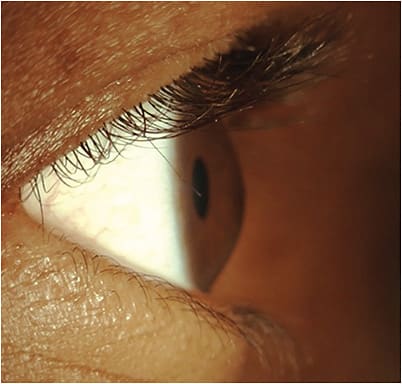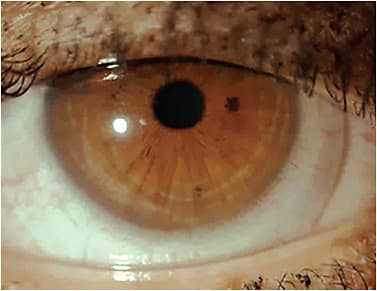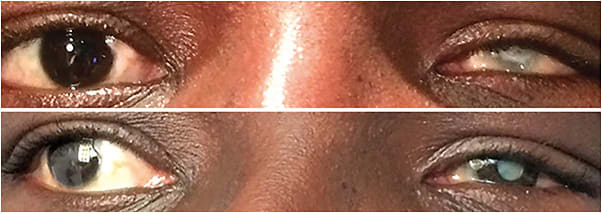
AT FIRST GLANCE, the soft contact lens market appears to comprise primarily “off-the-shelf” contact lenses that are limited to one diameter, one or two base curves (BCs), and a range of finite power options made by various manufacturers. “Off-the-shelf” lenses are designed to work for the average patient, but what if you don’t have average eyes or an average prescription?
This is where custom soft contact lenses (SCLs) may be beneficial. Custom soft lenses are indicated for three main groups of patients: 1) those whose eyes have a unique size and/or shape (e.g., a cornea that’s especially large, small, steep, or flat); 2) those who have a unique refractive error (e.g., high plus, high minus, or high regular astigmatism); and/or 3) those who have irregular astigmatism.
Custom soft lenses are available in both hydrogel and silicone hydrogel materials. They can be manufactured in virtually any parameter including diameter, BC, optical zone, central thickness, and most sphere powers, cylinder, and axis down to a single degree, all of which can be adjusted independently.
Some custom soft lenses are manufactured with reverse geometry designs, such as GP lenses in which the central BC is flatter than the secondary curve to allow the lens to align more closely to an oblate cornea (after refractive surgery). Additionally, custom soft lenses can be specially tinted to aid in handling, cosmesis, photophobia, and color discrimination, and in some cases can resolve diplopia regardless of whether a prescription is needed for vision or not.
THE NOT-SO-“REGULAR” CORNEA
The proper fitting of an SCL on the eye relies on matching the sagittal depth of the contact lens with the sagittal depth of the eye. Corneal diameter, or the horizontal visible iris diameter (HVID), is the primary factor that determines the sagittal depth of the cornea, which is the most important parameter to consider when fitting SCLs.1
After corneal diameter, corneal eccentricity (the rate at which the cornea flattens from the center to the periphery) has the second-greatest impact on fitting, while central corneal curvature is the least important.1 This means that relying only on keratometry readings can be misleading in custom soft contact lens fitting.2
One study found that the average HVID was 11.8mm to 12.0mm, with a range of 10.2mm to 13.0mm.3 Commercially available, “off-the-shelf” SCLs are manufactured to fit the average HVID, which applies to approximately 77% of eyes. However, if you extrapolate this data to the general population, approximately 23% (or one-quarter of your patient base) are outliers. These patients would benefit from being fit in custom SCLs to accommodate their smaller- or larger-than-average corneal diameter.3
While a one-size-fits-all SCL is convenient, improper lens fits account for approximately 20% of annual lens dropouts.4 An SCL should overlap the limbus by at least 0.5mm in all quadrants. The general rule of thumb when determining lens diameter is to add 2mm to the HVID to ensure that it provides sufficient corneal coverage and on-eye stability.5
A large cornea fit with an “off-the-shelf” soft lens may not properly drape over the cornea due to an insufficient sagittal depth. This can cause the lens to move excessively with the blink, demonstrate fluting of the edge, and lead to mechanical irritation of the cornea and conjunctiva as well as hyperemia.
Conversely, the same SCL on a small cornea can result in a tight fit due to excessive sagittal depth, which reduces lens movement, inhibits tear exchange, and can lead to hypoxic stress. Utilization of profilometry may be beneficial in designing custom soft lenses in addition to scleral and orthokeratology lenses.6
INDICATIONS FOR CUSTOM SCLs
Although there’s a wide range of parameters available in commercially available extended range SCLs, there are still parameter limitations that may inhibit patients from achieving their best vision. Custom SCLs can be utilized for any refractive error (myopia, hyperopia, or astigmatism), but perhaps where they are especially beneficial is via the opportunity to provide an optically superior outcome for presbyopes. Being able to tailor a custom multifocal (MF) design to a patient’s specific anatomical and distinct visual demands can only improve SCL success.
In addition to patients who have regular corneas, custom SCLs can be prescribed for patients who have irregular corneas. However, understanding the differences in lens evaluation and setting patient expectations are keys for success with these patients.
Patients who have high regular or irregular astigmatism, post-surgical corneas, post-corneal collagen cross-linking, asymmetric keratoconus, and/or intolerance to corneal GP lenses can be quite successful with custom soft lenses. Custom soft lenses may also be less intimidating than corneal GP, hybrid, or scleral lenses for some patients, including new fits for keratoconus.
REGULAR CORNEA OFFERINGS
For patients who have regular corneas, custom SCLs work very similarly to their mass-produced counterparts, but they have significantly wider range of sphere and toric parameters. The powers can be as specific as one-eighth diopter steps and 1° axis increments. MF lenses allow for similar power and axis offerings but also have more customizable add powers (0.25D steps). Soft multifocal contact lenses have distance and near-center designs with an adjustable add zone size that can be customized to work with the patient’s pupil size.
There is also another unique feature: decentration of the add zone, which is important because we can apply what we know from studies about ocular shape and sclerals to soft lenses as well. The nasal sclera is steeper than the temporal sclera, causing soft lenses to decenter up to 1mm inferotemporally.7 The pupil is also decentered supero-nasally within the iris, which is opposite in direction to where the lens tends to favorably decenter.
Lastly, there’s the angle kappa (the angle between the visual axis and the center of the pupil) to contend with when attempting to properly align MF optics with not only the pupil but the patient’s line of sight.8 When misaligned, MF optics can induce spherical aberration and coma, further disrupting patient clarity, which is why custom MF SCLs that allow for this correction can significantly improve visual quality for some patients.9
Fitting a custom SCL for the regular cornea is no different than fitting a corneal GP lens for a regular cornea, as it can all be performed empirically. Many laboratories have their own algorithms and arc length calculators that consider keratometry, HVID, refractive error (RE), and eccentricity (when available).
The more information that is provided, the better the potential outcome. For MF SCLs, eye dominance, add power, pupil size in normal and dim illumination, and any pupillary location and angle kappa measurements can be valuable. Once the empirically designed lenses are received, they are assessed on the eye and fitting adjustments are made as needed to stabilize the fit; over-refractions are performed to enhance the optics.
WHAT ABOUT IRREGULAR CORNEAS?
Although GP lenses typically allow for better visual acuity as it pertains to irregular astigmatism, custom soft lenses may offer better initial comfort, centration, and some improvement to vision over spectacles or uncorrected vision. They provide a good option for patients who do not have critical vision needs or when other GP options fail.
There are an increasing number of lathe-cut custom soft irregular cornea designs available from different laboratories. They’re distinct from standard soft lenses in that they follow one of two fitting premises: 1) they have an increased center thickness (CT) to mask irregular astigmatism, or 2) they utilize an aspheric design to limit aberrations.
Most custom soft lenses are fit with a diagnostic fitting set; however, they can also be ordered empirically. An increasing number of custom SCLs can be designed using software compatible with corneoscleral tomography and profilometry.10 Regardless of the lens design utilized, it is recommended to follow the manufacturer’s fitting guide for initial lens selection, evaluation, and troubleshooting.
When choosing custom soft lens designs for the irregular cornea, the initial lens is generally selected based on sagittal height, not on base curve.1 Measuring corneal diameter or HVID is important, as it controls sagittal height. This can be measured manually with a ruler and is often provided with many topography/tomography systems.
For the same corneal curvature, the sagittal height/depth decreases as the corneal diameter becomes smaller, and vice versa; the sagittal height/depth increases as the corneal diameter becomes larger. Sagittal height can also be determined by observing corneal profile with the slit lamp, a transilluminator (Figure 1), corneoscleral profilometry, and anterior segment optical coherence tomography. Each custom soft lens will have a fitting guide that specifies how to select the initial lens based on corneal shape.

Patients who have higher levels of corneal irregularity often need increased levels of astigmatic correction, which can be very unstable for the patient. To mask corneal irregularity, custom soft lenses may be designed with an increased center thickness (0.3mm to 0.6mm).10 Increasing the center thickness also decreases higher-order aberrations and helps improve overall vision, but it also decreases oxygen transmission.10 Thus, further lens design and fitting modifications should be made.
Secondary to the thickness of the lenses, more movement is expected, up to 2mm with the blink, to minimize corneal hypoxia. Most custom soft lenses have a prominent optic zone, which can help visualize lens movement on the eye (Figure 2). Custom soft contact lenses can be manufactured of hydrogel or silicone hydrogel lens materials; the latter increases oxygen transmissibility11 (Figure 3).


Assessing stability of vision with the patient’s blink is a key step for success with custom soft lenses. The BC of a custom soft lens directly impacts vision, while the skirt or periphery directly impacts comfort and movement.12 The periphery of the lens can be modified separately from the BC to help eliminate the presence of air bubbles or fluting and achieve the appropriate amount of lens movement to facilitate tear exchange.
PROSTHETIC SOFT LENSES
Custom SCLs are not only used these days for improving vision and allowing patients to achieve spectacle independence, but they can also be used to therapeutically alter vision and to enhance cosmesis.
COLORED CONTACT LENS OPTIONS
Depending on a patient’s ocular condition, there are three different types of colored contact lenses that can be used cosmetically, therapeutically, or prosthetically.
Translucent Tinted These lenses are usually indicated for patients who want to augment their natural eye color, enhance their color perception (especially athletes or patients who have color deficiencies),13 or as a way of decreasing light transmission for patients who are photophobic.14
These lenses have a uniform single hue throughout and can be customized to have a clear, translucent-tinted, or black pupil. They can mask mild disfigurements and partial iris defects in those who have dark irides, but typically the pigment is not dense enough to block peripheral light transmission and reconstruct a significant amount of abnormal iris (unless using a total black annular ring). The color, iris diameter, shade of tint, and pupillary diameter can be customized, but this type of lens lacks iris and corneal details.
Computer-generated or hand-painted lenses are usually the best option for patients who need a prosthetic lens to mask significant anterior segment cosmetic irregularities or iris defects, because they allow the utilization of an opaque underprint to significantly block peripheral light and form a specific pupillary diameter.
Computer-Generated These lenses allow for a wide array of different colors and generated patterns via dot-matrix printing. To provide a more realistic look, many designs allow for layering of different colors, as well as the inclusion of iris details such as limbal rings and pupillary frills. Various colors of opaque underprints are available to provide full iris occlusion; however, the underprint color can impact the perceived color and iris detail of the front surface. They are reproducible with good consistency and don’t fade over time (Figure 4).

Hand-Painted This type of lens offers the most customizable appearance and because of that, it is also the most expensive option, requiring more time for fitting and manufacturing. However, more intricate ocular details can be added, such as iris flecks, coronas, limbal rings, and vasculature. This option allows for decentration to improve symmetry with the other eye.
Hand-painted lenses require true artistry, and because of that they are impossible to reproduce 100% and can fade over time, especially if the manufacturer’s cleaning recommendations aren’t followed. This option is especially useful for patients who want the most natural look and the best color match, particularly those who have lighter colored irides and need an opaque underprint for full iris and anterior segment reformation.
OTHER APPLICATIONS
Prosthetic or colored SCLs aren’t used only for cosmesis, they have several other uncommon applications that can enhance a patient’s quality of life. They can decrease symptoms of glare or photophobia by defining the pupil in patients who have iris defects due to conditions such as aniridia, polycoria, colobomas, iridectomies, or trauma. They can act as filters for patients who are photophobic, either from lack of pigmentation (albino patients), or have retinal conditions like cone dystrophies and achromatopsia.15
For patients who play sports, tints can be used to enhance contrast sensitivity. Additionally, a black pupil or all-black contact lens (pupil and iris) can remove all extraneous visual information to eliminate undesirable diplopia.
Ultimately, when fitting SCLs for these purposes, it’s always important to acknowledge the emotional impact of using custom SCLs for prosthetic purposes, and it’s imperative to spend time having a conversation with the patient to understand their goals and set appropriate expectations for success.
TAKEAWAYS
The art of fitting contact lenses depends on a relationship between the lens and the cornea, but with today’s mass-produced SCL offerings, it’s easy to forget the importance of corneal shape. Practitioners should realize that even the best soft lenses will fail occasionally, and taking a moment to sit back and evaluate the shape of the eye can help elucidate why. In addition, using custom SCLs in practice can help optimize the soft lens experience for patients who may have been told they could not wear CLs, failed with CLs previously, or desire to enhance their quality of life. CLS
References
- Young G. Ocular sagittal height and soft contact lens fit. Cont Lens Anterior Eye. 1992;15(1):45-49.
- Young G, Schnider C, Hunt C, Efron S. Corneal topography and soft contact lens fit. Optom Vis Sci. 2010 May;87:358-366.
- Caroline P, André M. The Effect of Corneal Diameter on Soft Lens Fitting, Part 1. Contact Lens Spectrum. 2002 Apr;17:56. Available at clspectrum.com/issues/2002/april-2002/contact-lens-case-reports . Accessed Sep. 20, 2023.
- Young G. Why one million contact lens wearers dropped out. Cont Lens Anterior Eye. 2004 Jun;27:83-85.
- Henry VA. Soft Contact Lens Fitting and Evaluation. In: Bennett ES, Henry VA. Clinical Manual of Contact Lenses (5th edition) Wolters Kluwer, Philadelphia, 2014:300-318.
- Viñuela JR, Piñero DP, Martínez MB. Comparing sagittal heights calculated using corneal parameters and those measured with profilometry. Cont Lens Anterior Eye. 2023 Apr 1;46:101747.
- Cox I, Kollbaum P, Papas E. Advances in Optics Drive Soft Lens Success. Rev Contact Lenses. 2021 Mar/April:20-25. Available at reviewofcontactlenses.com/article/advances-in-optics-drive-soft-lens-success . Accessed Sep. 20, 2023.
- Kumar DA, Agarawal A, Jacob S. Angle kappa may play important role in success of multifocal IOLs. Ocular Surgery News. 2010 May 10. Available at healio.com/news/ophthalmology/20120331/angle-kappa-may-play-important-role-in-success-of-multifocal-iols . Accessed Sep. 20, 2023.
- Fedtke C, Ehrmann K, Thomas V, Bakaraju RC. Association between multifocal soft contact lens decentration and visual performance. Clin Optom (Auckl). 2016 Jun 28;8:57-69.
- Chang C, DeNaeyer GW. Specialty Contact Lenses: Treat Your Keratoconus Patients Right. Rev Cornea Contact Lens. 2017 Mar/April:14-17. Available at reviewofcontactlenses.com/article/specialty-contact-lenses-treat-your-keratoconus-patients-right . Accessed Sep. 20, 2023.
- Situ P, Simpson TL, Jones LW, Fonn D. Effects of silicone hydrogel contact lens wear on ocular surface sensitivity to tactile, pneumatic mechanical, and chemical stimulation. Invest Ophthalmol Vis Sci. 2010 Dec;51:6111-6117.
- Andrzejewski T. Managing Irregular Corneas With Soft Lenses. Rev Cornea Contact Lens. 2020 Jan/Feb:12-16. Available at reviewofcontactlenses.com/article/managing-irregular-corneas-with-soft-lenses#:~:text=Custom%20soft%20lens%20designs%20for%20the%20irregular%20cornea%20typically%20are,advanced%20irregularity%20and%2For%20scarring . Accessed Sep. 20, 2023.
- Yeung KK, Wong R. Colored Contact Lenses: More than a Pretty Eye. Rev Cornea Contact Lens. 2020 Jan/Feb:18-23. Available at reviewofcontactlenses.com/article/colored-contacts-more-than-a-pretty-eye . Accessed Sep. 20, 2023.
- Schornack MM, Brown WL, Siemsen DW. The use of tinted contact lenses in the management of achromatopsia. Optometry. 2007 Jan;78:17-22.
- Severinsky B, Yahalom C, Sebok TF, Tzur V, Dotan S, Moulton EA. Red-tinted contact lenses may improve quality of life in retinal diseases. Optom Vis Sci. 2016 Apr;93:445-450.



